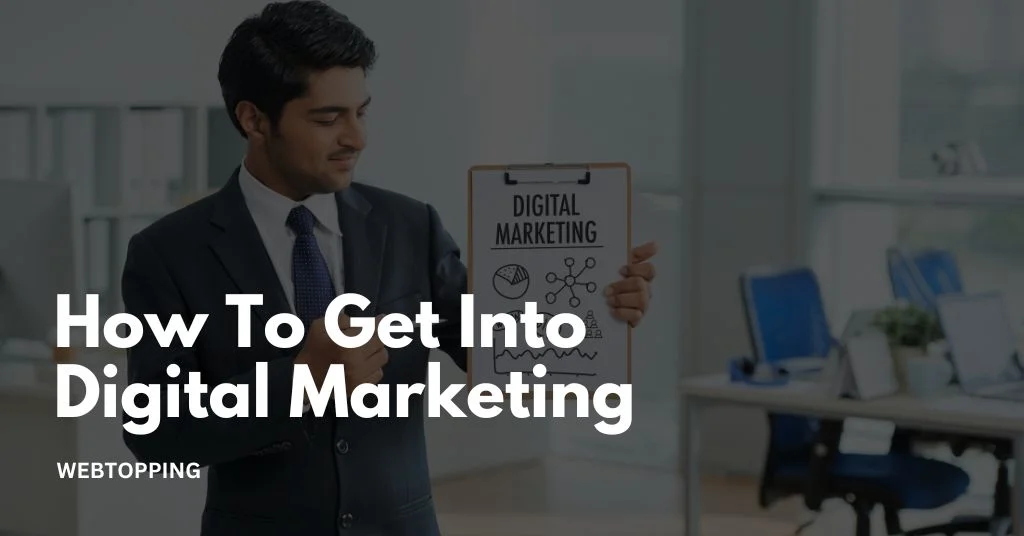How to Get into Digital Marketing in 2025

If you want to start a career in digital marketing in 2025, the best way is to first learn the basics. Digital marketing includes things like SEO (making websites show up on Google), social media marketing, email marketing, writing content, and online ads. You can find free and paid courses on websites like Google Digital Garage, Coursera, and HubSpot. These courses help you understand how digital marketing works and give you certificates too.
After learning, try to get some practice. You can start your own blog, help a friend’s business, or do small projects for local shops. You can also look for internships or freelance jobs. Try to build a portfolio that shows what you can do. This will help you when applying for jobs. Joining online groups on LinkedIn or going to free webinars is also useful. It helps you meet other people in the field and learn more. Digital marketing is growing fast, so keep learning and practicing to build a good career.
What Does a Digital Marketer Do?
A digital marketer is someone who promotes products or services using the internet and other digital channels. Their main goal is to help businesses reach more people online, attract potential customers, and turn those people into actual buyers.
Daily Tasks of a Digital Marketer
Here are some common activities digital marketers do:
1. Content Writing: They write blog posts, product descriptions, website content, and more. Good content helps attract people to the website and keeps them engaged.
2. Social Media Management: They post on platforms like Facebook, Instagram, LinkedIn, or Twitter. The aim is to connect with people, share useful content, and build a loyal audience.
3. Online Advertising: They create ads on platforms like Google Ads, Facebook Ads, or Instagram. These ads help bring more visitors to a business’s website or increase sales.
4. Email Marketing: They design newsletters or email campaigns to keep in touch with customers. Emails can share news, promotions, tips, or offers.
5. Video Marketing: They create videos for platforms like YouTube or Instagram. Videos can be tutorials, brand stories, customer reviews, or product promotions.
6. SEO (Search Engine Optimization): They make sure a website ranks higher on Google by using the right keywords, writing quality content, and fixing technical issues.
7. Analyzing Data: Using tools like Google Analytics, they check how people are behaving on a website. This helps understand what is working and what needs improvement.
Why Choose a Career in Digital Marketing
Digital marketing offers endless growth opportunities, creativity, and flexibility. With businesses shifting online, the demand for skilled marketers is rising. You can work across industries, learn new tools, and build a rewarding career with global reach. If you’re thinking about starting a career in digital marketing, here are some strong reasons why it could be the perfect path for you:
1. High Demand
Digital marketing is in high demand as businesses shift online to connect with customers. Companies need skilled professionals to manage SEO, social media, ads, and content. The rise in e-commerce and digital services has made digital marketing roles essential for growth. Whether it’s startups or large corporations, there’s a continuous demand for talent, ensuring job security and a steady flow of career opportunities across different industries.
2. Versatility
Digital marketing offers a wide range of roles like SEO specialist, content writer, PPC expert, social media manager, and email marketer. This versatility allows professionals to explore different paths based on their skills and interests. Whether you’re analytical or creative, there’s a niche for you. The flexibility in roles also means you can shift specialties as the market changes, helping you stay relevant and adaptable in your career.
3. Creativity and Innovation
Digital marketing is the perfect field for those who love thinking outside the box. From designing eye-catching campaigns to creating engaging content and visuals, there’s constant room for creative expression. Marketers use storytelling, branding, and innovative strategies to connect with audiences. As trends evolve, professionals must innovate to stay ahead, making it a dynamic field that encourages fresh ideas and creative experimentation every day.
4. Data-Driven Decision-Making
In digital marketing, data plays a major role in shaping strategies. Marketers use analytics tools to track user behavior, campaign performance, and conversions. This data helps make informed decisions that improve ROI and campaign effectiveness. Professionals can adjust tactics in real-time based on insights, making marketing more precise and results-oriented. Understanding data and metrics is key to success, allowing marketers to balance creativity with measurable outcomes.
5. Constant Learning
Digital marketing is always changing with new tools, trends, and algorithms. This makes it an ideal career for those who love learning and staying updated. From mastering Google Analytics to adapting to social media algorithm updates, professionals must continually upgrade their skills. Online courses, webinars, and certifications help keep knowledge fresh. This constant evolution keeps the work exciting and offers endless opportunities to grow and improve professionally.
6. Remote Work Opportunities
Many digital marketing roles can be done remotely, making it ideal for people who value flexibility and work-life balance. With just a laptop and internet connection, professionals can manage campaigns, hold virtual meetings, and analyze data from anywhere. This opens up global job opportunities and allows for freelancing or agency work from home. The remote-friendly nature of digital marketing suits the modern lifestyle and supports personal freedom.
7. Impactful Work
Digital marketing lets you make a visible impact by helping brands grow and reach new audiences. Whether it’s increasing website traffic, improving sales, or building brand awareness, your work produces real, measurable results. Seeing your strategy succeed gives a sense of accomplishment. You help businesses connect with their customers and drive meaningful engagement. This ability to influence growth and success makes the role highly fulfilling and rewarding.
8. Global Reach
Digital marketing connects brands to global audiences through online platforms. As a digital marketer, your campaigns can reach people across countries and cultures, breaking geographical barriers. You gain insights into international trends, customer behavior, and market dynamics. This global perspective enhances your experience and opens up worldwide job opportunities. Working with international clients or remote teams gives your career a broader, more enriching outlook in the global economy.
How to Get Into Digital Marketing with No Experience
You don’t need to have worked in marketing before to begin. In fact, many professionals learn how to start digital marketing with no experience through self-study and freelancing
Step-by-Step Guide to Start Digital Marketing
Let us now break down how to start digital marketing in simple steps that anyone can follow.
1. Learn the Basics of Digital Marketing
Before diving in, it’s important to understand what digital marketing actually involves. This includes areas like SEO, social media marketing, pay-per-click (PPC) advertising, email marketing, affiliate marketing, content writing, and video marketing. Each of these plays a role in helping businesses grow online.
Use free beginner-friendly resources like:
- Google Digital Garage
- HubSpot Academy
- Coursera
- YouTube tutorials
- Learn basic terms, tools, and strategies used in the digital space
- Explore each field to figure out what interests you most
2. Build Practical Digital Marketing Skills
Once you understand the basics, start practicing to gain real experience. Learning theory is helpful, but digital marketing is a hands-on field. Practicing regularly helps you build confidence and apply your knowledge.
Tools and platforms to try:
- Google Ads: Practice creating search and display ads
- Canva: Design eye-catching social media graphics
- Mailchimp: Create email marketing campaigns
- Google Analytics: Learn to analyze website traffic
- WordPress: Build and manage simple websites
Start small by writing blog posts, managing social media, or running a test campaign with a small budget
3. Earn a Digital Marketing Certification
Certifications help you prove your skills, especially if you don’t have a college degree in marketing. They show that you’re serious and knowledgeable. Many platforms offer industry-recognized certificates that employers value.
Top platforms offering free or low-cost certifications:
- Google (Google Ads & Analytics)
- Meta (Facebook Blueprint courses)
- HubSpot Academy
- Coursera & LinkedIn Learning
These certificates can strengthen your resume and help you get jobs or freelance projects
4. Choose a Digital Marketing Path
Digital marketing has many branches. After exploring them, choose one path to focus on first. Specializing helps you grow faster and makes you more competitive. You can always expand your skills later.
Common paths to choose from:
- Content Marketing: ideal if you enjoy writing
- Social Media Management: for those who love creativity and trends
- SEO & SEM: perfect if you’re data-driven and analytical
- Video Marketing or YouTube Management: for creative visual thinkers
Choosing one path gives clarity and direction to your learning journey
5. Start Building a Portfolio
A portfolio is proof that you can do what you claim on your resume. Employers and clients want to see examples of your work, especially if you’re starting without prior job experience. A strong portfolio builds trust and sets you apart from other beginners.
What to include in your portfolio:
- Blog posts you’ve written
- Social media pages you’ve managed
- Screenshots of email campaigns or ad results
- Brief descriptions of what you did and why
- Use platforms like WordPress, Notion, or Behance to showcase your work
6. Apply for Internships or Freelance Projects
To gain real-world experience, apply for internships, entry-level jobs, or freelance work. Even unpaid or low-paid opportunities are valuable at the beginning because they help you build a track record and gain testimonials.
Where to find opportunities:
- LinkedIn – for digital internships and job postings
- Internshala – especially useful for beginners in India
- Upwork & Fiverr – to try freelance gigs
- Local businesses – offer to help them with social media or ads
Every project helps you gain skills, testimonials, and confidence
7. Network and Create a Personal Brand
Digital marketing is all about online presence, and that includes you. Building a personal brand helps you connect with industry experts, attract job offers, and grow your influence. You don’t need to be an expert to start, just be consistent and share your learning journey.
Tips to build your personal brand:
- Be active on LinkedIn, Twitter, or Instagram.
- Share what you’re learning, the tools you’re using, and project results.
- Post tips, small wins, and case studies.
- Join Facebook groups, WhatsApp groups, and attend webinars.
- Engage with posts by marketers and companies to build relationships.
8. Stay Updated with Digital Marketing Trends
The digital world changes quickly. Google updates its algorithm, Facebook changes its ad policies, and new tools emerge all the time. Staying updated ensures your strategies remain effective and relevant.
How to stay updated:
- Follow top blogs like Moz and HubSpot.
- Subscribe to marketing newsletters.
- Join LinkedIn and Reddit marketing groups.
- Attend webinars and digital events.
9. Start a Personal Project or Side Hustle
If you want to stand out, start your own digital project. It could be a blog, affiliate website, social media page, or YouTube channel about something you’re passionate about. This helps you apply multiple digital marketing skills in one place, and also gives you full control to experiment and grow.
Ideas for personal projects:
- A blog about fashion, food, travel, tech, or any hobby.
- An Instagram page about memes, quotes, or tips.
- A YouTube channel reviewing books or tutorials.
- A small affiliate marketing site to earn passive income.
10. Create a Simple Resume and Keep Applying
Even with just certifications, personal projects, or internships, you can create a strong resume that gets noticed. Keep it clear, honest, and focused on results. Apply consistently, and don’t be discouraged by rejections they are part of the journey.
Tips to build your digital marketing resume:
- Mention certifications with issuing platforms and dates.
- Add links to your portfolio and personal projects.
- Include tools you’ve used (Google Ads, Canva, Mailchimp, etc.).
- Customize your resume and cover letter for each job.
- Use job boards like LinkedIn, Indeed, AngelList, and Naukri.
Conclusion
Starting a career in digital marketing is easier than ever, even without prior experience or a formal degree. By learning the basics through free courses, practicing with small projects, and building a strong portfolio, anyone can enter this growing field. Digital marketing offers creativity, flexibility, and high demand across industries. Whether you choose content writing, SEO, social media, or paid ads, the career path is filled with opportunities to grow and succeed. Keep learning, stay updated with trends, and network with others in the field to stay ahead. With dedication and the right skills, you can build a rewarding career in digital marketing and even explore freelancing or start your own business in the future.
Frequently Asked Questions
Start by learning free online courses on platforms like Google Digital Garage and HubSpot. Build skills in SEO, social media, and ads. Create a portfolio through internships, freelance work, or your own blog. Gain experience, stay updated, and network to grow.
To start a digital marketing business, begin by learning essential skills such as SEO, Google Ads, social media strategy, and analytics. Then, choose your niche, register your business, build a professional website, and set clear pricing packages.
Yes, a digital marketing business can be highly profitable. With low startup costs and high demand, especially from small and medium businesses, you can earn consistent revenue with the right strategy, pricing, and client management.
When researching how to get a job in digital marketing, look for entry-level roles like SEO analyst, content creator, social media assistant, or digital marketing trainee. These help you gain experience and move up to more advanced roles over time.
Having a website helps build trust and gives your business a home online. While not required at the very beginning, most people learning how to start online marketing eventually create one to support their marketing efforts and track results.
How to Get into Digital Marketing in 2025 Read More »















